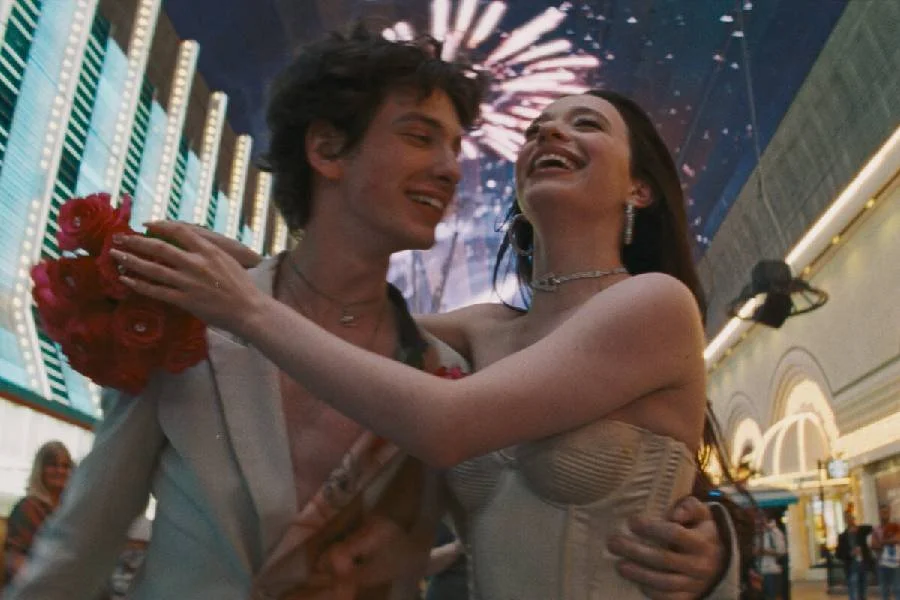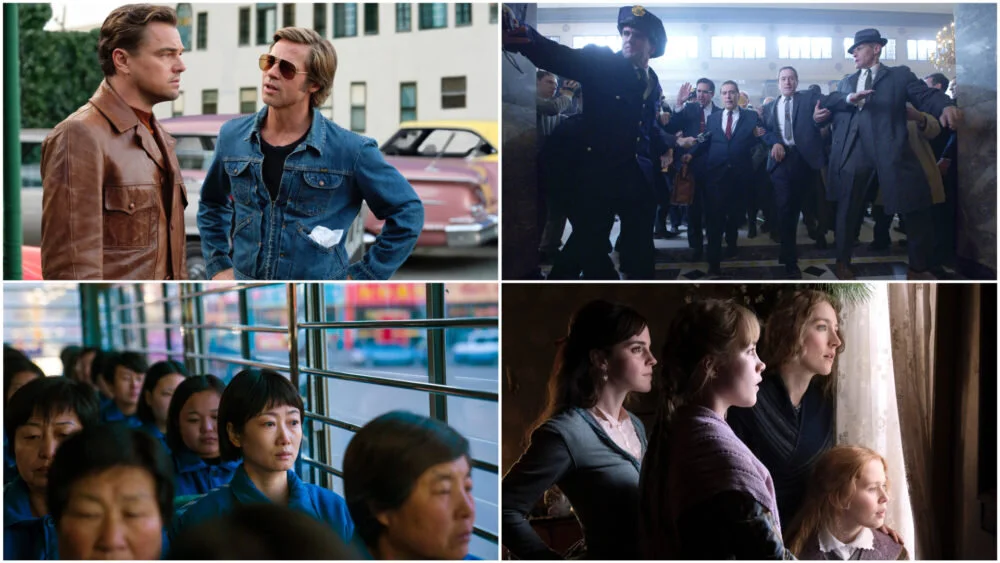Film Essay: Top Ten 2024
Top Ten Films 2024
As an annual ritual, creating a top ten list gives me the chance to reflect upon the year and, quite often, I realize that it’s actually a pretty good year for cinema. Not this year. While I rewarded a good number of four-star movies (my highest distinction because I do not personally separate between excellent and above), there have only been two extraordinary films this year. Even of the four-star movies, many felt like small triumphs rather than bold statements, although my third favorite film is an exception to that. Of the major tent pole films, Wicked surpassed my limited expectations and turned out to be a descent film, although, unsurprisingly, no Wizard of Oz. Dune: Part II somehow felt both too long and yet too short for its epic story; however, the visual mastery of Denis Villeneuve is a breath of fresh air in this more harmonized multiverse era of filmmaking. Inside Out 2 managed to be a sequel with true vision, even if it felt underdeveloped at times. But so many movies were disappointing (Moana 2, Gladiator 2, Babygirll) or turned out to be fine fair rather than great (A Complete unknown, Challengers, Conclave, Emilia Perez, Sing Sing). Documentaries faired better this year with two in my top ten and several major ones I still have not seen. One director continues their place on my annual top ten list and that is Mike Leigh. Has there been a more reliable filmmaker over the years? Leigh’s unique method of creating films, where he gathers actors together with a premise to improvise for a month and then produce a screenplay, often creates some of the most lived cinema, jumping out of the screen as real, and exploring big issues of our time. Since 1999 all but two of the films he’s made have all made my top ten lists which counts 6 film (7 now including this year): Topsy-Turvey (1999), Vera Drake (2004), Happy-Go-Lucky (2008), Another Year (2010), and Mr. Turner (2014). And with that reflection, it has been a hard year for cinema and frankly a terrible year for the world, but here are my selections for the best films of the year:
10. I Saw the TV Glow ****
In general, I approach art from the point of view that I shouldn’t need outside information to understand a work’s artistic meaning. And yet, there are times when you approach something that is different, outside your frame of reference or understanding, sometimes from a different culture, and that outside knowledge can cause one to re-engage and understand with a deeper appreciation. Jane Schoenbrun’s I Saw the TV Glow was at first impenetrable to me. It seemed like a film about the influence of media on a lost teenager, Owen, who becomes obsessed with watching a teenage TV show, “The Pink Opaque”. But, upon reading that Jane Schoenbrun was allegorizing their personal experience of being trans, I re-engaged the film and was reminded of the importance of cinema. Roger Ebert called cinema an empathy machine. The trans community is one that I am not well acquainted and in my growing understanding of their stories, I Saw the TV Glow offered me an insight into one artist’s understanding of what it feels like to know that you are not yourself. In the end of the film, I first thought that Owen had discovered someone in his life wasn’t real, however upon second viewing, I came to understand that it was Owen who never existed.
9. Hard Truths
Mike Leigh has an amazing ability: finding humor in tragedy and emotional catharsis in the comedy. With Hard Truths, Mike Leigh returns to an actress, Marianne Jean-Baptiste, with whom he worked in his masterpiece Secrets & Lies, and here, he gives her a character to match her extraordinary talent. Marianne plays Pansy, a middle-aged woman who is angry, seemingly at everything, for seemingly no reason. Her every communication is extreme, providing for some hysterical moments. In what could be a tragedy, her and her sister, whom is her opposite, attempt to plan a visit to their mother’s grave on the anniversary of her passing. Pansy ain’t having it, and as she refuses to participate in the planning or outing, certainly we realize that Pansy has not accepted her mother’s passing. What is revealed as Pansy reacts negatively to all her family members is that hurt people often hurt others. Hard Truths finds great pain in Pansy’s past that is buried and not always specific, among a wonderful comedic character study.
8. The Old Oak ****
Ken Loach, one of the only ten directors to win the Palme d’Or twice, has had a long and distinguished film career. Ken Loach’s final film The Old Oak is a perfect coda as he announces his retirement since it contains all the hallmarks of a Loach film: a study of everyday life in a story about blue collar workers that involves social justice. Here, Loach crafts a story that could be the story of our times. In a small town in England, Syrian refugees arrive to the jeers and xenophobic complaints of the local townsfolk. Some welcome the new arrivals, but their charity is met by derision from the impoverished community who want to look after “their own”. The local church, once the center of town is now empty, and TJ, who owns the local pub, The Old Oak, provides a place of community for the different members of the town to come together in brotherhood. The movie doesn’t shy away from the harsh economic realities of the local citizens nor the need for empathy for those who have endured war and global atrocities. A great last film from the legendary Ken Loach.
7. Oh Canada ****
Adapting a novel to the screen is no easy task. Often, love of the source material can be detrimental to your own piece of art. Paul Schrader, one of the best screenwriters in film history, also felt the pressure of adapting his dear friend, Russell Banks’, most personal novel as Russell was dying. It’s remarkable that Paul Schrader discovered the perfect way to express the doubt of the main character, Leonard Fife (a great Richard Gere), a famed documentarian on his death bed being interviewed for a documentary, where his memory and fact collide, threatening the mythology of himself that he has built. The method of filmmaking involves having Fife’s younger self in flashbacks, played by Jacob Elordi, come into the present and replace the actor Richard Gere at times, while having the older Fife, played by Gere, sent back into his past. The result is an incredible look at how our memories shape our understanding of the world, and a brilliant portrait of finding meaning in life, at the moment it is passing.
6. Nickel Boys ****
Here is another director taking a big swing. Some felt that the daring cinematic choice worked incredibly well, others felt that it was a distraction and gimmick. For myself, I thought it worked most of the time and when it did, it was magic. In adapting Colson Whitehead’s novel about two black youths, Turner and Elwood, RaMell Ross chooses to cut between alternating first person point of view shots of the main characters. At times, it does feel like a gimmick to me, much like Birdman’s single shot, but when it does work, it demonstrates two viewpoints on a single subject and how experiences can change based on the individual. What is more successful is the use of light and dark in the film, which begins with a montage of light images, setting the tone for the boy’s lives before they are sent to a corrections school, based on a true place. The generational trauma that follows is clouded in darkness, but hope exists in moments of light.
5. No Other Land ****
Perhaps no other film is more important this year than No Other Land. Made by Palestinian and Israeli filmmakers and journalists (Basel Adra, Yuval Abraham, Hamdan Balla and Rachel Szor), it is a bold look at the forced displacement of Palestinians in the West Bank. Basel Adra grew up in Masafer Yatta, a small collection of villages in the West Bank, which Israel has claimed as training grounds for the Israeli military, and thus continually destroys homes. Basel’s father was an activist, and Basel continues his father’s work, trying to document the atrocities committed. Along with an Israeli journalist Yuval Abraham, these journalists have captured forced displacement on a human scale. Hearing a mother screaming that her daughters are still in a house being bulldozed and the uncaring response from an Israeli soldier is an image seared into my soul. While this does not capture the complexity of the entire Israeli-Palestinian conflict, it does capture the truth about settlements in the West Bank.
4. Sugarcane ****
It would be easy to dismiss Sugarcane as merely a documentary ripped from the headlines. In 2022, a mass grave of 50 unidentified Native American child remains were found on the former grounds of St. Joesph Mission, a Catholic school in Canada that ran as an institution of forced conversion and cultural assimilation until 1981. The news was shocking in its brutality, but not surprising for the Native Americans who have endured such atrocities for centuries. Julian Brave Noisecat, along with his co-director Emily Kassie, investigates not only the history of the school but Julian’s own family who have lived with PTSD and generational trauma. Julian and his family’s courage to explore their own trauma, history of abuse and substance abuse, gives a human face to stories that are too often cliff notes in Western history. Besides Anora, this was the most moving experience of the year.
3. The Substance ****
No other director swung for the fences the way Coralie Fargeat does in The Substance. This is a movie of extremes, and it will not be for everyone. While Demi Moore, as the aging and rejected former star Elisabeth Sparkle, and Margaret Qualley, as the drug created younger version of herself, are both incredible in the film, the star of The Substance is Coralie Fargeat’s direction. The film’s style sets its satirical and disturbing tone right in the beginning framing Denis Quaid’s movie producer Harvey (named for real life movie tycoon and monster Harvey Weinstein) in disgusting close ups. Just his smile or shot of him chewing food is enough to inspire creepy memes. Some will say that the ending of the movie, which is as shocking as The Fly was in its day, is too much, but I think it perfectly sums up the film’s theme that we must stop judging people by their appearance. It is only when her body is finally gone that Elisabeth Sparkle feels a sense of peace.
2. The Brutalist ****
In a time of technological innovation, and a number of directors taking dramatic creative swings this year (Coralie Fargeat [The Substance]. RaMell Ross [Nickel Boys], Jane Schoenbrun [I Saw the TV Glow], Francis Ford Coppola [Megalopolis]), and not always successful, Brady Corbet’s film feels like a throwback to the past. Even shot in Vista-vision and containing an intermission, The Brutalist seems classical in the tragic story of an immigrant architect, Laszlo Toth (in a career best performance by Adrian Brody), who after surviving the holocaust flees to America to both rebuild his life and build the future. The fact that this movie came out in the same year as Megalopolis is kind of astonishing: both films are about architects who are symbolically trying to build a better world, involve thematic elements about the importance of art, and forces of the status quo in the form of money and politics fighting against the hope of a new world. That The Brutalist succeeds while Megalopolis fails could be because of the focus of The Brutalist. In the end, Coppola’s Megalopolis concludes hopefully… I think? … but The Brutalist ends tragically, perfectly setting up our present world.
1. Anora ****
Sean Baker is one of the best new directors of his generation. Since his first film Tangerine, he has continually crafted movies that are unique and personal out of classic or cliché storylines, finding truth and beauty in horrific circumstances. Sean Baker’s The Florida Project was my choice for the best film of 2017, whose plot had the potential to be a Hallmark movie of the week. Similarly, Anora has the shape of being another clone of Pretty Woman about a sex worker who ends up being hired by a rich man only for the two to fall in love. But, Anora escapes all of those cliches by being true and intimate in the moment. Mikey Madison, in a revelatory performance, plays Anora (Ani) as a young woman who despite her circumstances knows her worth and understands the gravity and seriousness of the situations, she finds herself in. Her whirlwind romance is full of passion and intense sexuality, but she is never blind. The result is the most human, real, and moving film of the year.
Runners up:
11. I’m Still Here ****
12. Civil War ****
13. The Seed of the Sacred Fig ****
14. The Wild Robot *** ½
15. Night is not Eternal *** ½
16. Dune: Part II *** ½
17. Small Things Like These *** ½
18. September 5 *** ½
19. His three Daughters *** ½
20. All we Imagine as Light *** ½
Best Actor: Adrian Brody, The Brutalist
Runner Up: Ralph Fiennes, Conclave
Best Actress: Marianne Jean-Baptiste, Hard Truths
Runners Up: Mikey Madison, Anora
Best Support Actor: Jesse Plemons, Civil War
Runner Up: Guy Pearce, The Brutalist
Best Supporting Actress: Zoe Saldana, Emilia Perez
Runner Up: Danielle Deadwyler, The Piano Lesson
Best Cinematography: Greig Fraser, Dune: Part II
Runner Up: Rob Hardy, Civil War
Best Art Direction: Patrice Vermette, Dune: Part II
Runner Up: Nathan Crowley, Wicked
Best Editing: Benjamin Rodriguez Jr., Oh Canada
Runner Up: Hansjorg WeiBbrich, September 5
Best Score: Alex G, I Saw the TV Glow
Runner Up: Daniel Blumberg, The Brutalist
Best Screenplay: Sean Baker, Anora
Runner Up: Mohammad Rasoulof, The Seed of the Sacred Fig
Best Adapted Screenplay: Paul Schrader, Oh Canada
Runner Up: Murilo Hauser, Heitor Lorega, I’m Still Here
Best Animated Film: The Wild Robot
Runner Up: Inside Out 2
Best Documentary: Sugarcane
Runner Up: No Other Land
Best Director: Coralie Fargeat, The Substance
Runner Up: RaMell Ross, Nickel Boys
Worst Film of the Year: Unfrosted
For another perspective on the year, I turn to one of my favorite film critics, a colleague and dear friend, Groucho Reviews. Here are his choices for the best films of the year: https://www.grouchoreviews.com/features/67717c41cdea777a17053665
















